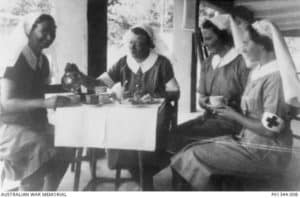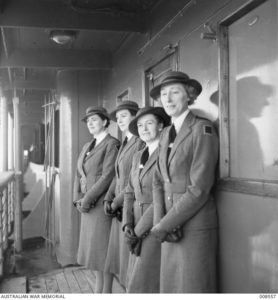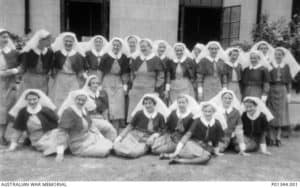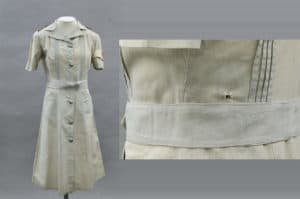How do you deal with life, especially during those times, when the good and the bad happened to you all at the same time?
For Australian nurse Sister Vivian Bullwinkel, it was a matter of following her primal instinct of survival and bravery when everything suddenly hits the fan.
The story of Vivian Bullwinkel was a story that got lost over time, but it is equally necessary to remember her history, nonetheless. She was well-known as the sole survivor of the Bangka Island Massacre that happened on February 16, 1942 on the Radji Beach of Bangka Island (Indonesia) during the heat of World War II. Out of the 22 nurses held captive on the shores of Bangka Island, she was the only one who made it out alive. It was a good thing she survived, but it was also a bad thing that she was the only one who survived.
Her dedication in trying to save the civilians under her care at the time of war would be her shining legacy until the end, despite having her head already an inch closer to the stake. And this is her tale.
The Nurse with Flat Feet
Born in Kapunda, South Australia in 1915, Vivian Bullwinkel trained as a nurse in Broken Hill, a town where her father worked as a miner in one of the mining companies. In 1938, she completed her general training at the Broken Hill and District Hospital, and completed Midwifery in 1939. She continued to work as a staff nurse at the Kiaora Private Hospital in Hamilton, Victoria, later on transferred to Jessie McPherson Hospital in Melbourne from 1940 to 1941. In here, she met Wilma Oram, a nurse who would be her long term friend in the coming years during and after the war.
Vivian initially applied as a nurse with the Royal Australian Air Force (RAAF), but unluckily failed the medical examination because of a silly reason: she had flat feet. But this rejection did not cause Vivian’s spirit to waver. She held on to the pursuit of putting her life on the line.
Together with Wilma, they signed up to work as volunteers in the Australian Army Nursing Service (AANS), and was accepted in 1941 as members of the neophyte group, the 13th Australian General Hospital (13th AGH).
That same year in the month of September, their unit sailed on the Hospital ship named Wanganella towards an unfamiliar territory. This territory would eventually become known as Singapore in the coming years.
Life in Singapore
In the first few weeks upon their arrival, the nurses started to miss home. Singapore was far from their home, and tracing back the steps back would mean a sign of weakness and having cold feet.
Vivian and the nurses spent their days doing medical and elective surgical cases, noting that the equipments were underprivileged and the conditions of the hospital’s environment poor. But despite the insufficient supplies and living in fear of the unknown, she still had the time to socialize with the nurses and the soldiers working with her unit, grabbing a few drinks and dancing with men at night. Writing in her diary became her little bit of blue sky, and every bit of experience that she had was diligently noted in.

At this rate, Vivian and her fellow nurses would think that this was not a scene of war, and it might seem like the extent of the war was just a matter of false advertising. They were actually having a pretty fair time in that country. But their assumptions would soon change abruptly in December of 1941.
Downfall of Singapore
On the same morning that Pearl Harbor was attacked on December 7, 1941, General Yamashita’s 25th Army started to invade Malaya. Some parts of Singapore were also bombed. The Japanese began to rise in strength and was surging like a raging fire down the Malaysian Peninsula towards the island of Singapore.

The nurses suddenly found themselves overwhelmed with too many wounded men and women to tend to. All of a sudden, Vivian saw with her own eyes the purpose as to why she signed up as a volunteer for the AGH. This is what they came for, and they are instantly losing touch from exhaustion due to working overtime. This is reality, and they have their hands finally full of it.
By the end of January 1942, the 13th AGH was forced to evacuate to another location, where they transformed St. Patrick’s School into a makeshift hospital in such haste. Bomb after bomb dropped within the vicinity, plus wounded patient’s streamed inside the facility nonstop. The nurses held fast in this kind of battlefield. It would be a matter of time before the next target would be where they are.
On February 8, 1942, Colonel A. P. Derham, the Assistant Director for Medical Services for the 8th Division, and Lt. Colonel Gly White had known that the moment to escape was now an immediate need. The nurses would be the top priority. Anyone who would not be able to make it would be left behind.
Two days after, in a heartbeat, the nurses were forced to get out of the facility at the last minute despite their persistent refusal to abandon their patients. They were tasked to bring as much casualties that they could carry aboard the nearest ship that they could find. Some were given only with one hour notice to pack what they could carry and run to the port where the ships were waiting. Time was ticking out. Emotions of guilt from leaving their patients behind and the fear for their lives are breaking their hearts into pieces. They were losing safe ground and the world around them was crashing down at their feet.
Emotions of guilt from leaving their patients behind and the fear for their lives are breaking their hearts into pieces.
With all the chaos of fighting for survival, Vivian, together with 64 other nurses, were finally able to get on board the SS Vyner Brooke on February 12 at 5:00 in the afternoon. There was no turning back. There was nothing to turn back to.
A Series of Unfortunate Events:
The Destruction of the SS Vyner Brooke
As the darkness loomed in, the SS Vyner Brooke started to set sail away from the hellish situation of Singapore. Just like in the movies, men, women, and children inside the Vyner Brooke looked on at the scene before them: the whole city was wrapped with violent fires, columns of smoke were covering the night sky, and the silence of forthcoming death gripped their hearts with fear.

The ship was originally built to carry only 12 passengers, but at that time, it managed to hold 265 passengers including Vivian and the nurses, all cramped and terrified of the gathering pandemonium in the city. The ship was also lacking supplies, food, and water. It was a suicide survival, but the risk was better than staying in the city that has already succumbed to the hands of the Japanese.
But the start of what could have been their escape was immediately riddled with bad luck. In the dark, the captain of the Vyner Brooke inadvertently directed the ship into a minefield, causing them to halt their progress and stay in the dark for hours until daybreak.
“Bullets from machine guns hailed from above puncturing lifeboats, body parts…”
February 13th, a Friday, the ship with its passengers spent the day hiding behind islands, trying to ward off any chance of being detected by the enemy via land, sea, and most importantly, by air. The captain knew that if they risk going out into the open sea, it would be too easy for the Japanese to locate them as the day was clear and sunny –perfect for flying scouts and drones and fighting jets. They were being hunted down, for sure. The captain could not take any chances.
So they continued their journey at night, making a successful trip, finally reaching the Bangka Strait, but not for long, as daytime eventually came. They were out in the dangerous open sea yet again. At around 2 pm of February 14, the ship started receiving attacks from above. They were panicking. An aerial attack was the last thing that they had hoped for. The moment that they had feared had arrived, and they were eventually detected.
Bullets from machine guns hailed from above puncturing lifeboats, body parts, and the body of the ship altogether in a symphony of chaos. Civilians were struggling and fighting to keep themselves alive, and if they could only walk on water, they would. But alas, the ship was destined to meet its end in these waters. There was no safe place to land.

Bombs started to hit the funnel, the bridge, and the aft section of the ship. Like a paper boat, the ship began to sink within a matter of 15 minutes. Within the said 15 minutes, the civilians were badly injured and the nurses, including Vivian, has to give their best in saving as many casualties as possible, bringing them into the bullet-punctured lifeboats, abandoning the ship as this is of necessity.
Vivian recalled, “Those that weren’t keen to leave, we gave a helping hand to.” One lifeboat was said to have contained the children and the elderly. As they were lowered down, however, the Japanese planes started raining down peels of bullets to them, and the lifeboat turned over. Some of the civilians never made it out alive, as bullets started to rip them apart while they tried to swim towards somewhere safe.
True to her love for her profession, she ushered and protected the civilians without second thoughts, never rushing about saving herself first.
Vivian, after seeing that most of the civilians were already in the lifeboats, started to evacuate the sinking boat by climbing down the rope ladder. True to her love for her profession, she ushered and protected the civilians without second thoughts, never rushing about saving herself first. Hanging unto the side of one of the lifeboats with half of her body dipped in the water as it was already packed with civilians, they were able to reach the shores of Bangka Island by late afternoon, guided by a beacon of light coming from a bonfire that was already created by earlier survivors that made it to the shore.
Behind Enemy Lines:
The Bangka Island Massacre
Exhausted, hungry, tormented with thirst, shaken with so many emotions from a series of trauma, and with no shelter from the cold, the survivors kept on arriving on the shores of Bangka Island all through the night. By morning, an approximate 60 survivors consisting of men, women, and children and 22 members of the AANS were huddled together on the Radji Beach.
A team of survivors, including Vivian and five other nurses, decided to scout the perimeter for available food and water. A small village was found but the castaways were never given a helping hand from the local villagers in the fear of the Japanese retaliation. They were advised to surrender themselves to the Japanese instead.
That night at the beach, they watched as another violent battle took place on the sea, lighting up the horizon with a deadly show of fire and destruction. Later, a large lifeboat brought a fresh wave of survivors, British servicemen, bringing the number of survivors to almost a hundred, huddled on the beach.
After much deliberation between themselves, it was decided to accept the advice of the villagers. Some of them were alarmed at the idea, and warned that it might be detrimental for all of them. A few felt scared after remembering what a soldier told them while they were still in Singapore, tending to his wounds. “The Japanese didn’t like taking in prisoners,” the soldier said.
“They’re not taking prisoners.”
“When the boys had come to the hospital [in Singapore] their one cry had been ‘they’re not taking prisoners.” Vivian warned, “It doesn’t matter what member of the forces came in. Their cry was the same: ‘they’re not taking prisoners.’ However, when you’re young and you’ve got a group of over 100 people, you can’t imagine anything happening to that. And every confidently felt that we would not be taken prisoners because of safety in numbers.”
But as the children became more agitated from starvation and fatigue for more than 48 hours, they decided to take the devil by the hindmost, and risk it. After all, what could go wrong? Thus they sent a small group of the civilians ahead of the pack in the hopes of finding the Japanese camps, and surrender in peace.
Matron Drummond, one of the senior nurses, suggested that everyone should start walking after the first batch to keep the children distracted from their hunger pains. The mothers, children and other civilian women started to press on, leaving behind Matron Drummond, the 21 nurses (Vivian included) tending to the injured, and an elderly woman who wished to stay with her injured husband. This decision by Matron Drummond would serve as their saving grace, buying them time away from the grave.
Sometime after they left the beach, Vivian noticed the arrival of the Japanese troops. They did not look like they are tripping for some prisoners as they immediately ordered half of the men to stand, and marched them at bayonet point down to a secluded part of the beach, out of their sight behind a headland. A few minutes after that, the Japanese returned and gathered the remaining men, and forced them to march the same path.
“Eventually the senior officers turn with a party of Japanese and he informed him…he was just brushed aside,” she said. “We just looked at each other and said ‘they’re not taking prisoners.’ And we seem to accept that fact.”
The nurses and the elderly woman were the only ones left on the beach. At the time, one of the nurses uttered a remark, saying “There are two things I hate the most, the sea and the Japs, now I’ve got them both!” The nurses laughed nervously, but their blood runs cold as rifle shots began firing at the direction where the men went to.
“There are two things I hate the most, the sea and the Japs, now I’ve got them both!”
The Japanese ominously returned, holding their rifles and bayonets that were dripping with fresh blood. They sat down in front of the women, cleaned their bayonets in silence, then motioned them to stand up once the cleaning of their weapons were done. The silence of the women were deafening, not one single whimper of fear was heard, all brave souls marching down the beach to meet their impending fate. It is time to face death. No one asked what to do, and no one made an attempt to run or fight. Fighting would be futile to be dared. They knew that the men were all dead.
The soldiers positioned all 22 nurses and the old woman to line up on the knee high surf, all facing the horizon in a straight line. The sound of their beating hearts, the wind brushing their faces, the nurses looked on the horizon, contented to face their end with no struggle or strife. No tears, no screams, no show of fear.
“Chin up, girls. I’m proud of you and I love you all.”
Matron Drummond then spoke, “Chin up, girls. I’m proud of you and I love you all.”
The Japanese then began to open fire from behind them in a cold blooded scene of murder, sparing no one.
“We were then ordered to march into the sea, we got out to almost waist-deep when they started shooting from behind,” Vivian recalled.
22. 21. 20. 19. Down to where she was standing, all the way to the person at the end of the line. One by one, in a single sweeping motion, the nurses fell on top of the other, like dominoes, lifeless and helpless as they disappear beneath the shallow waters, blood sprayed into the breeze and into the sea. An impact suddenly threw her face down into the waves. She was hit in the torso! As she floated, swallowing salt water in the process, she found that she was not yet dying.
“…they started shooting from behind.”
Wave upon wave of nausea pulsed through her because of the pain, but her instincts were calling her to hold it in, else fresh waves of bullets would be buried into her to finish her off. Feigning death, she was careful not to make a single movement, and held her breath for what felt like an eternity, sucking in minimal air as she could to survive, her heart beating faster for the fear of getting discovered that she was still alive. It was evident that there was no mercy in these twisted men as they walked up the beach and bayoneted who they deemed was still alive. The currents slowly washed her ashore. The world is still turning for Vivian after all.
“When I was hit I can remember thinking it’s like the kick in the mule and then I went down. I was very surprised to find myself still alive. I just laid there and eventually let the waves bring me in.”
After some time, as the night began to cover the horrors of the massacre on the shores, she took the courage to sit up as slowly as possible. She was alone on the beach. She tried to move, but another wave of nausea took over her as an excruciating pain swiftly shot out from her left hip, paralyzing her torso.

“The bullet that hit me struck me at the waistline and just went straight through,” she realized. She was badly wounded and bleeding, with a possibility that her vital organs were damaged by the bullet’s trajectory, but nevertheless, she was alive. “I looked around and there was no sign of anybody. There was nothing,” she later recalled. “Just me.”
Walking down a narrow path, staying clear out of the enemy, she crept away from the beach wading through the corpses and blood of her colleagues, her prime intention was to hide in the jungle. But after walking some twenty yards inside the forest, she was overcome with the need to lay down. “I don’t know whether I became unconscious or whether I slept,” she said. She slipped momentarily into the dark, and her world went black as she passed out.
She later came to, disoriented, parched, and with only one thing in her mind. The springs. She must have water. She tried to get up from her hiding place, but then halted as she spotted some ruthless Japanese walking on the beach at a distance. “My heart went to the bottom of the feet again,” she said. Like a deer in the headlights, she remained as still as she could, until she was sure that the Japanese had left. At that moment, she had another brush of death. The Japanese missed her yet again.
Fighting to Live
When the coast was clear, she rushed and abandoned her hideout, shaking as she made it to the springs. The water was like a ray of hope, and she greedily drank the spring water like it was going to run dry at any minute. All of a sudden, she heard a male voice behind her, saying, “Where have you been, nurse?”
“Where have you been, nurse?”
It was Private Pat Kingsley, a British soldier, who was also severely wounded, but had survived after being shot together with the men. Together, they kept each other concealed in the jungle and alive. Despite having her own wounds to mend, she made sure that Private Pat was given assistance, bringing what food she could gather from the local villagers. They remained hidden in the jungle for 12 days, until Vivian realized that they could not go on like that for a long time. Together with Private Kingsley, they decided that they would just give themselves up to the Japanese, and hope to be taken as prisoners yet again. A weak Kingsley agreed, but only with one condition in his mind. “I’ll be thirty nine tomorrow,” he mused, “And I’d like to think I had my thirty ninth birthday, free.” She responded with, “Time is no object,” and celebrated the next 24 hours in the jungle for his birthday and their last hours as free individuals.
Harsh Years of Incarceration
February 28, 1942. Vivian and Pat approached the Japanese camps, and were given entry to the prison walls. Vivian saw familiar faces. One of them was Wilma! Together with 30 other nurses, Wilma had unknowingly survived the sinking of the Vyner Brooke, something that Vivian never thought was possible.
Off to the next page! Continue reading…
Source
Hello I'm cambell by name, I'm giving a testimony about Dr.Emmanuel the great Herbalist, he has the cure to all manner of diseases, he cured my herpes disease, though I went through different website I saw different testimonies about different spell casters and herbalist, I was like: 'Many people have the herpes cure why are people still suffering from it?' I though of it, then I contact Dr. Emmanuel via email, I didn't believe him that much, I just wanted to give him a try, he replied my mail and Needed some Information about me, then I sent them to him, he prepared it (CURE) and sent it to Airfreight Online Courier Service for delivery, he gave my details to the Courier Office, they told me that 3-5 days I will receive the package and i took the medicine as prescribed by him and I went for check-up 2 weeks after finishing the medicine, I was tested herpes negative, if you are herpes positive do me a favor for you to contact him and I will try my possible best to make sure you get cured, when you contact him, make sure you tell him that I referenced you.. contact him via: nativehealthclinic@gmail.com or WhatsApp +2348140073965
BalasHapus